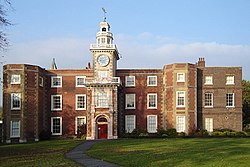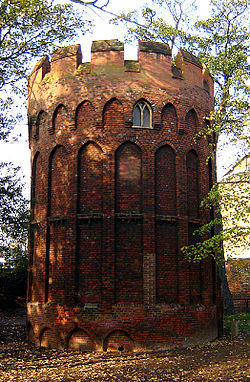Bruce Castle
| Bruce Castle | |
| Middlesex | |
|---|---|
 Bruce Castle | |
| Location | |
| Grid reference: | TQ33409066 |
| Location: | 51°35’56"N, 0°4’31"W |
| History | |
| Manor house | |
| Information | |
Bruce Castle (formerly the Lordship House) is a 16th-century or possibly 15th century manor house in Lordship Lane in Tottenham, in the east of Middlesex. It is a Grade I listed building.
The house is named after the House of Bruce who formerly owned the land on which it is built. Believed to stand on the site of an earlier building, about which little is known, the current house is one of the oldest surviving British brick houses. It was remodelled in the 17th, 18th and 19th centuries.
The house has been home to Sir William Compton, the Barons Coleraine and Sir Rowland Hill (reformer of the Post Office), among others. It served as a school during the 19th century, during which time a large extension was built to the west. It has since was converted into a museum on local history and, on the strength of its connection with Sir Rowland Hill, the history of the Royal Mail. The building also houses the council archives.
Since 1892, the grounds have been a public park, Tottenham's oldest.
Origins of the name

The name Bruce Castle is derived from the House of Bruce, who had historically owned a third of the manor of Tottenham. However, there was no castle in the area, and it is unlikely that the family lived nearby.[1] Upon his accession to the Scottish throne in 1306, Robert I of Scotland forfeited his lands in England, including the Bruce holdings in Tottenham,[1] ending the connection between the Bruce family and the area. The former Bruce land in Tottenham was granted to Richard Spigurnell and Thomas Hethe.[2]
The three parts of the manor of Tottenham were united in the early 15th century under the Gedeney family and have remained united since.[2] In all early records, the building is referred to as the Lordship House. The name Bruce Castle first appears to have been adopted by Henry Hare, 2nd Baron Coleraine (1635–1708),[1] although Daniel Lysons speculates in The Environs of London (1795) the name's use dates to the late 13th century.[2]
Architecture

A detached, cylindrical Tudor tower stands immediately to the south-west of the house, and is generally considered to be the earliest part of the building;[3] however, Lysons believes it to have been a later addition.[2] The tower is built of local red brick, and is twenty-one feet tall, with walls three feet thick.[3] In 2006, excavations revealed that it continues for some distance below the current ground level.[4] It was described in 1829 as being over a deep well, and being used as a dairy.[5]
Sources disagree on the house's initial construction date, and no records survive of its construction. There is some archaeological evidence dating parts of the building to the 15th century;[3] William Robinson's History and Antiquities of the Parish of Tottenham (1840) suggests a date of about 1514,[6] although the Royal Commission on Historic Monuments attributes it to the late 16th century. Nikolaus Pevsner speculates the front may have formed part of a courtyard house of which the remainder has disappeared.[7]
The Grade I mansion's principal facade has been substantially remodelled. The house is made of red brick with ashlar quoining and the principal facade, terminated by symmetrical matching bays, has tall paned windows. The house and detached tower are among the earliest uses of brick as the principal building material for an English house.[8]
Henry Hare, 2nd Baron Coleraine (1635–1708) oversaw a substantial remodelling of the house in 1684, and much of the existing south facade dates from that time. The end bays were heightened, and the central porch was rebuilt with stone quoins and pilasters, a balustraded top and a small tower and cupola.[7] A plan from 1684 shows the hall in the house's centre, with service rooms to the west and the main parlour to the east. On the first floor, the dining room was over the hall, the main bedchamber over the kitchen, and a lady's chamber over the porch.[7]
In the early 18th century Henry Hare, 3rd Baron Coleraine (1694–1749) oversaw a remodelling of the north of the house, that added a range of rooms to the north and the Coleraine coat of arms to the pediment of the north facade.[7] In the late 18th century, under the ownership of James Townsend, the narrow east facade of the house was remodelled into an entrance front, and given the appearance of a typical Georgian house. At the same time, the south front's gabled attics were removed, giving the house's southern elevation its current appearance.[7] An inventory of the house made in 1789 in preparation for its sale listed a hall, saloon, drawing room, dining room and breakfast parlour on the ground floor, with a library and billiard room on the first floor.[7]
In the early 19th century, the house's west wing was demolished, leaving it with the asymmetrical appearance it retains today.[9] The house was converted into a school, and in 1870 a three-story extension was built in the Gothic Revival style to the northwest of the house.[7]
The 2006 excavations by the Museum of London uncovered the chalk foundations of an earlier building on the site, of which nothing is known.[4] Court rolls of 1742 refer to the repair of a drawbridge, implying that the building then had a moat.[3] A 1911 archaeological journal made passing reference to "the recent levelling of the moat".[10]
Heraud's Tottenham
Bruce Castle is among the buildings mentioned in John Abraham Heraud's 1820 Spenserian epic, Tottenham, a romantic depiction of the life of Robert the Bruce:[11]
[12]Lovely is moonlight to the poet's eye,
That in a tide of beauty bathes the skies,
Filling the balmy air with purity,
Silent and lone, and on the greensward dies—
But when on ye her heavenly slumber lies,
TOWERS OF BRUS! 'tis more than lovely then.—
For such sublime associations rise,
That to young fancy's visionary ken,
'Tis like a maniac's dream—fitful and still again.
Present day

Bruce Castle is now a museum, holding the archives of the local council, and housing a permanent exhibition on the past, present and future of Haringey and its predecessor boroughs, and temporary displays on the history of the area. Other exhibits include an exhibition on Rowland Hill and postal history,[11] a significant collection of early photography, a collection of historic manorial documents and court rolls related to the area, and one of the few copies available for public reading of the Spurs Opus, the complete history of Tottenham Hotspur.[13]
In 1949, the building was Grade I listed;[14] the round tower was separately Grade I listed at the same time,[15] and the 17th-century southern and western boundary walls of the park are Grade II listed.[16][17]
In 1969 the castle became home to the regimental museum of the Middlesex Regiment[18] whose collection was subsequently transferred to the National Army Museum.
In July 2006 a major community archaeological dig was organised in the grounds by the Museum of London Archaeological Archive and Research Centre, as part of the centenary celebrations of the opening of Bruce Castle Museum,[4] in which large numbers of local youths took part.[19][20] As well as large quantities of discarded everyday objects, the chalk foundations of what appears to be an earlier house on the site were discovered.[4]
Outside links
| ("Wikimedia Commons" has material about Bruce Castle) |
References
- ↑ 1.0 1.1 1.2 Pegram 1987, p. 2
- ↑ 2.0 2.1 2.2 2.3 Lysons, Daniel 'The Environs of London' Volume 3 (1795), pages 517–557
- ↑ 3.0 3.1 3.2 3.3 Pegram 1987, p. 3
- ↑ 4.0 4.1 4.2 4.3 Bruce Castle Park community excavation, 2006, Museum of London, 2006, http://www.museumoflondon.org.uk/collections-research/laarc/community-excavations/bruce-castle-park/, retrieved 2 October 2008
- ↑ The Mirror of Literature, Amusement, and Instruction Vol. 13, No. 350. (3 January 1829)
- ↑ Robinson 1840, p. 216
- ↑ 7.0 7.1 7.2 7.3 7.4 7.5 7.6 Nikolaus Pevsner: The Buildings of England: Middlesex, 1951 Penguin Books ISBN 978-0140702033page 584
- ↑ Nikolaus Pevsner: The Buildings of England: Middlesex, 1951 Penguin Books ISBN 978-0140702033page 11
- ↑ Pegram 1987, p. 9
- ↑ A History of the County of Middlesex - Volume 2 pp 1-14: Ancient Earthworks (Victoria County History)
- ↑ 11.0 11.1 Haringey, Hidden London, http://www.hidden-london.com/brucegrove.html, retrieved 2 October 2008
- ↑ Heraud, John Abraham (1820), Tottenham: A Poem, http://spenserians.cath.vt.edu/TextRecord.php?textsid=39266, retrieved 6 August 2017
- ↑ Fontaine, Valley (26 September 2008), "Spurs well and truly books, Bruce Castle Museum", BBC News, https://www.bbc.co.uk/london/content/articles/2008/09/26/haringey_spurs_opus_feature.shtml, retrieved 2 October 2008
- ↑ National Heritage List 1358861: Bruce Castle (Grade I listing)
- ↑ National Heritage List 1294388: Tower to the Southwest of Bruce Castle (Grade I listing)
- ↑ National Heritage List 1079218: Southern boundary wall to Bruce Castle Park (Grade II listing)
- ↑ National Heritage List 1294666: Wall along western boundary to grounds of Bruce Castle (Grade II listing)
- ↑ A History of the County of Middlesex - Volume 5 pp 324–330: Tottenham: Manors (Victoria County History)
- ↑ Financial statement, year ending 31 March 2007, Museum of London, 4 October 2007, p. 17, http://www.molg.org.uk/NR/rdonlyres/10A84A59-BDCA-410A-9227-B24A71AD1BC3/0/MoLAccounts07.pdf, retrieved 2 October 2008
- ↑ Locals invited to muck in at Bruce Castle, Museum of London, 3 July 2006, http://www.molg.org.uk/English/NewsRoom/Archived06/BruceCastle.htm, retrieved 2 October 2008
- Bibliography
- Cherry, Bridget; Pevsner, Nikolaus (1998), The Buildings of England, London 4: North, London: Penguin, ISBN 0-14-071049-3, OCLC 40453938
- Clifford, Anne (1990), The Diaries of Lady Anne Clifford, Stroud: Alan Sutton, ISBN 0-86299-560-4, OCLC 59978239
- Connor, Jim (2004), Branch Lines to Enfield Town and Palace Gates, Midhurst: Middleton Press, ISBN 1-904474-32-2, http://www.middletonpress.co.uk/index.php
- Lake, G.H. (1945), The Railways of Tottenham, London: Greenlake Publications Ltd, ISBN 1-899890-26-2
- Olsen, Donald J (1976), The Growth of Victorian London, London: Batsford, ISBN 0-7134-3229-2, OCLC 185749148
- Pegram, Jean (1987), From Manor House... to Museum, Haringey History Bulletin, 28, London: Hornsey Historical Society, ISBN 0-903481-05-7
- Robinson, William (1840), History and Antiquities of the Parish of Tottenham (2 ed.), London, OCLC 78467199
- Underwood, Peter (1992), The A–Z of British Ghosts, London: Chancellor Press, ISBN 1-85152-194-1, https://archive.org/details/azofbritishghost0000unde